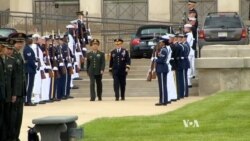PENTAGON —
One of China's top military leaders visited the Pentagon Thursday for meetings with his U.S. counterpart, a year after the two met in Beijing. It was the latest stop on a tour that began with visits to U.S. battleships in California. The high-level visit comes as there are growing concerns about Beijing's activities in the South China Sea.
A full honors cordon - band playing, handshakes and salutes - as General Fang Fenghui, chief of the general staff of the Chinese People's Liberation Army arrived at the Pentagon.
It’s a visit that comes at a critical time as China’s decision to place an oil rig in disputed waters of the South China Sea turned deadly this week with protests in Vietnam.
General Fang defended China's drilling, giving no indication China intends to back down. “Vietnam has dispatched vessels and ships for disruptions of that activity. And that is something we are not able to accept.”
Fang also placed blame on countries like the Philippines, Manila protesting China’s attempt to build an airstrip on a disputed reef.
“We do not make trouble. We do not create trouble. But we are not afraid of trouble," he said. "For the territory that has [been] passed down by our ancestors into the hands of our generation, we cannot afford to lose [an] inch.”
Chairman of the U.S. Joint Chiefs of Staff, General Martin Dempsey, was equally blunt. “We had a rich discussion of the status quo and who has been seeking to change it. We spoke about the fact that the use of military assets is provocative and it does increase risks,” he said.
Heightening tensions - Washington’s Asia pivot, something Chinese officials contend has emboldened some countries to start trouble.
Still, analysts contend it is dangerous to underestimate what China is doing.
James Hardy with IHS Jane’s Defense Weekly, said via Skype, "Traditionally China’s had kind of a long, strategic view of how it’s going to improve its position within Asia, whether that’s East Asia looking out toward Japan or Southeast Asia looking out toward the South China Sea.”
General Fang’s visit is part of a larger tour aimed at emphasizing cooperation. It included visits to the nuclear-powered aircraft carrier the USS Ronald Reagan and an appearance at the National Defense University.
U.S. officials hope the more the two militaries talk, the easier it will be to avoid misunderstandings...and the more progress they can make on issues that concern both nations, like a nuclear North Korea.
A full honors cordon - band playing, handshakes and salutes - as General Fang Fenghui, chief of the general staff of the Chinese People's Liberation Army arrived at the Pentagon.
It’s a visit that comes at a critical time as China’s decision to place an oil rig in disputed waters of the South China Sea turned deadly this week with protests in Vietnam.
General Fang defended China's drilling, giving no indication China intends to back down. “Vietnam has dispatched vessels and ships for disruptions of that activity. And that is something we are not able to accept.”
Fang also placed blame on countries like the Philippines, Manila protesting China’s attempt to build an airstrip on a disputed reef.
“We do not make trouble. We do not create trouble. But we are not afraid of trouble," he said. "For the territory that has [been] passed down by our ancestors into the hands of our generation, we cannot afford to lose [an] inch.”
Chairman of the U.S. Joint Chiefs of Staff, General Martin Dempsey, was equally blunt. “We had a rich discussion of the status quo and who has been seeking to change it. We spoke about the fact that the use of military assets is provocative and it does increase risks,” he said.
Heightening tensions - Washington’s Asia pivot, something Chinese officials contend has emboldened some countries to start trouble.
Still, analysts contend it is dangerous to underestimate what China is doing.
James Hardy with IHS Jane’s Defense Weekly, said via Skype, "Traditionally China’s had kind of a long, strategic view of how it’s going to improve its position within Asia, whether that’s East Asia looking out toward Japan or Southeast Asia looking out toward the South China Sea.”
General Fang’s visit is part of a larger tour aimed at emphasizing cooperation. It included visits to the nuclear-powered aircraft carrier the USS Ronald Reagan and an appearance at the National Defense University.
U.S. officials hope the more the two militaries talk, the easier it will be to avoid misunderstandings...and the more progress they can make on issues that concern both nations, like a nuclear North Korea.










